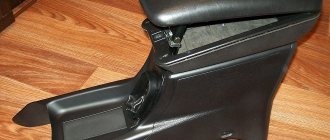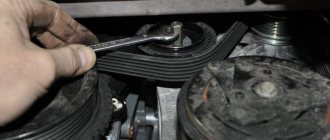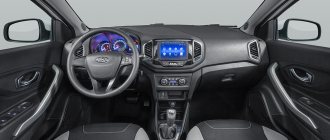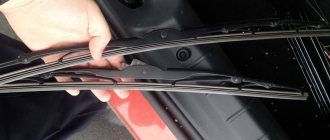More than six months have passed since the release of a new product from the domestic automobile industry - the Lada Vesta station wagon and its cross-country version. However, the shortcomings of the Lada Vesta SV Cross migrated from the Vesta sedan, which has been in production for more than three years.
Undoubtedly, any car has disadvantages - be it a nine for 50 thousand rubles or an Audi for 10 million. They exist and will exist, which is why there are such a large number of modern cars. So that from this large pile of cars, every person can choose something suitable for themselves. Disadvantages can be subjective or objective. Objective disadvantages are those shortcomings of machines that clearly affect the characteristics of the machine. For example, light bulbs in headlights burn out quickly - this is an objective disadvantage. But for some, a low seating position or a small trunk is a serious drawback. These disadvantages are subjective. Today we will talk about all the shortcomings of the Lada Vesta SV Cross and its derivatives. Of course, some of the disadvantages for many will not appear in all West station wagons, and some are generally just disadvantages for me. Maybe for some this will be a plus. So, let's go.
Objective disadvantages and disadvantages of Lada Vesta Cross SV
1. Creak of anti-roll bar bushings. This “jamb” migrated from the sedan. And the plant still has not solved this problem. Its essence lies in the fact that almost immediately after leaving the gates of the car dealership, the rubber bands of the anti-roll bar of new cars begin to creak wildly. The fault lies only in the poor quality of the material from which they are made. Everything can be solved quite simply - by installing rubber bands and brackets from Kia Rio or Hyundai Solaris.
2. Rattling and whistling of side mirrors. This problem also came from the Vesta sedan. I don’t know whether the car was tested in a wind tunnel or not, but the mirrors whistle very loudly at speed, and generally rattle on bumps. Perhaps the car was conceived in a pipe, but it was probably done without mirrors.
3. Rattling of plastic inserts in door trims. Yes, they certainly make unpleasant sounds that are very annoying. The way out of the situation is to disassemble the door card and glue everything with special materials.
4. Windshield washer nozzles. They have very low performance, so part of the glass remains dry and the wiper scratches it over time. Either you need to pour a lot of liquid so that everything is cleaned well, or come to terms with the fact that by 50 thousand km there will be traces from the wipers on the glass.
5. Lack of locks for the front passenger mats. Because of this, the rug constantly moves to the side, which entails dirt getting under it. There are no complaints about the driver's carpet at all - everything is securely and correctly secured and does not move anywhere. But the passenger has problems.
6. Next comes another serious drawback of the Lada Vesta SV Cross - the multimedia system screen. It manifests itself especially clearly in sunny weather - nothing is visible on the display, and it is basically impossible to control such a system.
7. Right engine mount mounting bolts. In this case, the bolts are delivered to the factory with obvious defects. Of the three cars, two of them simply break off at the very beginning of the car's operation. The way out of the situation is to buy new bolts and then replace them.
At the moment these are all objective disadvantages. Of course, over time, the list of shortcomings will be replenished, as the mileage of the cars will increase more and more. But that's all for now.
Let's not slow down!
The previous robot did not allow us to start from second gear. Because of this, in icy conditions I sometimes had to involuntarily skid. Now a “winter” operating algorithm has been introduced into the control unit. Just don’t look for a key with a snowflake near the gear selector in Vesta. The second gear must be engaged manually by moving the lever to manual control mode. After jerking around in the “creeping” mode, I was skeptical, but in the “winter” mode the car starts moving quite confidently - although, of course, with the help of the right pedal. Pass!
Subjective disadvantages and disadvantages of Lada Vesta Cross 2020 - 2018
The most serious drawback is the robot box, which is currently being installed on the assembly line and which migrated here from Priora. Yes, AvtoVAZ said that they completely redesigned it and tuned it.
But in fact, everything remained unchanged. Both on Priora and on Vesta. The robot also delays with switching, it can freeze, it can switch too early, so that the car nods. I read a lot on forums that the robot is adaptive and over time adapts to the driver’s driving style. But this didn’t happen to me. IMHO, mechanics, in this case, is the most preferable option.
The second disadvantage of the Lada Vesta SV Cross is that the suspension is very noisy. Now I’m not talking about specific breakdowns, when you change something and the noise disappears. It's all about the work itself. Even a fully operational car that rolls off the production line immediately starts to become noisy when entering the highway. Yes, if you moved from nine, you will feel progress and quiet operation of the suspension. And if you moved from the same Kia Rio or Solaris, which are Vesta’s classmates, you will undoubtedly understand that Vesta is much noisier.
The third subjective drawback of the Lada Vesta SV Cross is poor sound insulation. In the cabin you can hear the noise of the wheels, all the joints and unevenness of the road very well. And also a lot of crickets. Many Vesta sedan and station wagon owners simply coat the car with sound insulation immediately after purchase.
Next we move on to ergonomics. As for me, the controls for the power windows and heated seats are not very conveniently located. The power windows do not have an automatic mode. The seat belts are not located quite correctly, which is why it is not as convenient to fasten as in most foreign cars. Although over time you get used to it. If the steering wheel is made of imitation leather, it is not very comfortable, since in the heat your hands sweat and it becomes slippery.
What kind of oil to pour into the engine
When reviewing the 1.8 engine for the Lada Vesta Cross, you cannot skip the question of choosing engine oil. First of all, you should start from the operating features of the vehicle. Assess the climate in your region. This indicator will help you choose a liquid with a suitable viscosity. The vehicle's operating instructions recommend using oils of 5W-30, 40, 10W-40, and 15W-40.
For regions with cold climates, you should take a closer look at more liquid products, while new engines can even be filled with 0W-40 oil. For warm climate zones, as well as for the summer, you can fill in 15W-40 oil.
The next important parameter is the quality class. The manufacturer recommends taking liquids whose class reaches GF-4 or higher. This rule should not be neglected, since, as mentioned above, engines are very demanding on oil.
It will also be interesting to read: Review of the new Nissan Qashqai: the best crossover from Japan in 2020
We won’t advise anything regarding the manufacturer - there are many articles on this topic, and even here you need to start not so much from the brand as from the technical parameters of a particular substance. In general, look at how the engine will behave when using this or that oil.
Addition: review of Lada Vesta SV Cross Station Wagon
Good day everyone. Well, after a short acquaintance with the Lada Vesta Cross SV, which was successfully sold in 1 day after three months of ownership (my review about it is on this portal for anyone interested), I decided to switch to Mazda again, this time CX-5, I drove the first generation CX-9 for 3 years before Vesta, so the comparison will mainly be with it, which is quite logical. A few words why Mazda. In fact, there were several main criteria: 1. The power of the car should not exceed 200 hp. (tax), and not 150 hp. — otherwise the difficult crossover will be vegetable; 2. All-wheel drive; 3. Automatic transmission; 4. As funny as it may be, the presence of a plastic body kit all around with the obligatory condition that the body kit covers the sills from the outside (the short operation of Vesta was overshadowed by the daily dirtying of the clothes of the whole family and a spoiled mood); 5. Atmospheric non-turbocharged gasoline engine; 6. Cost no more than 1 million rubles; 7. At the same time, the car should not be either Chinese or German (I think people will understand me). I didn’t have to think long, because from owning the CX-9 I was left with only the best impressions, especially since my colleagues and neighbors had CX-5s for several years already, I had the opportunity to take a ride and, being in constant interaction, hear and compare the opinions of the owners, as they say from firsthand I also considered the option of purchasing a Qashqai-2, but in the end I refused because of the CVT. There are enough offers on the market, but for myself I have already decided to take exclusively with a 2.5 l 192 hp engine, in the maximum configuration, preferably with two sets of winter/summer wheels, from under one owner and with the lowest possible mileage, and as much as possible fresh, and did not exceed 1 million rubles)). I’ll say right away that the task was not an easy one). Basically, the secondary market is dominated by offers with a 2.0 liter engine, besides, in order for ALL the required conditions to coincide, it was necessary to monitor the Internet quite closely every day, call/write to the owners of the cars being sold almost throughout Russia, excluding the Far East and the Far North. And so the car was chosen (it turned out to be a worthy option in Perm), purchased and driven in at the beginning of May 2020 - 2013; in original paint, max. equipped with a black leather interior (except for the sunroof), 2 sets of wheels - summer 19”, winter 17”; 2 sets of mats (rubber rubber and + textiles) with a mileage of 66 thousand km, I paid 995 thousand rubles for it. I took it to a friendly service center to have the chassis troubleshooted, everything is perfect, NOT ONE recommendation for replacement, even for small things! So, let's move on to the comparison. The first impressions are the most vivid, the car drives and handles just great and is very exciting! Acceleration is instant and very confident, faster than the CX-9, that’s for sure, less than 8 seconds to 100 km/h according to measurements from reviewers) At the same time, in comparison with the “big brother” it rides noticeably softer. In reality, there is always a sufficient reserve under the gas pedal, I also really liked the operation of the 6-speed automatic transmission - the reactions to switching are instantaneous, no hesitation.
Main disadvantages of the motor
It is worth noting that, although manufacturers took into account the shortcomings of the 21128 engine from the Lada Priora Sport, this engine also has a number of shortcomings. The motor has been available for use for about 2 years, so users have been able to evaluate all its strengths and weaknesses. First of all, it needs to be emphasized here:
- extraneous noise from hydraulic compensators. In principle, knocking noises from this unit are a typical problem with all 16-valve engines made by AvtoVAZ. Basically, the problem occurs due to the fact that there is not enough working fluid in the power unit (it hasn’t been added for a long time, or there is a leak). In addition, the same symptom appears when using low quality oil. If you run everything too hard, you will have to completely replace the hydraulic compensators. It is worth noting that there is nothing wrong with this, since such repairs will cost you very little;
- increased consumption of working fluid. Motors of this type consume quite a lot of oil. As a rule, this occurs in the event of a failure of the connecting rod and piston group. You can get out of this situation only if you completely replace the faulty elements.
It will also be interesting to read: In Subaru Forester, fuel consumption per 100 km varies from 5.5 to 20
In principle, there are no further special comments regarding the functioning of the Lada Vesta Cross engine. If you maintain it correctly, the unit will last up to 200 thousand kilometers without problems. At the same time, the engines demonstrate excellent performance with both a manual gearbox and automatic transmission. By the way, the resource of the latter is exactly the same as that of the mechanics.
Engine disadvantages
The engine of the Lada Vesta is a modification of the 16-valve Priora engine. For some, it rattles when not warmed up or at idle or whistles. Whistling is generally typical for such a motor, so you can simply ignore it.
The weak link of such engines remains the electrics: some complain about the electronic gas pedal, starts on the 2-3rd attempt even when it’s warm, and unstable idle. A Vesta with a Euro-5 engine needs only high-quality gasoline; left-handed gasoline can cause hang-ups and bent valves.
The new 1.8 engine for Vesta can please you with increased oil consumption at the beginning of movement. There is a theory that the cause may be poorly processed valve stems made in China, which AvtoVAZ quickly replaced with others, thus eliminating the problem.











